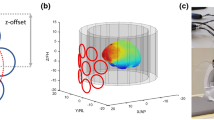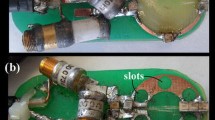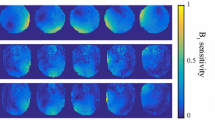Abstract
Objective
As the MRI main magnetic field rises for improved signal-to-noise ratio, susceptibility-induced B0-inhomogeneity increases proportionally, aggravating related artifacts. Considering only susceptibility disparities between air and biological tissue, we explore the topological conditions for which perfect shimming could be performed in a Region of Interest (ROI) such as the human brain or part thereof.
Materials and methods
After theoretical considerations for perfect shimming, spherical harmonic (SH) shimming simulations of very high degree are performed, based on a 100-subject database of 1.7-mm-resolved brain fieldmaps acquired at 3T . In addition to the whole brain, shimmed ROIs include slabs targeting the prefrontal cortex, both or single temporal lobes, or spheres in the frontal brain above the nasal sinus.
Results and discussion
We show “perfect” SH shimming is possible only if the ROI can be contained in a sphere that does not enclose sources of magnetic field inhomogeneity, which are gathered at the air-tissue interface. We establish a \(\sim{13}\)Hz inhomogeneity hard shim limit at 7T for whole brain SH shimming, that can only be attained at shimming degree higher than 90. On the other hand, under limited power and SH degree resources, 3D region-specific shimming is shown to greatly improve homogeneity in critical zones such as the prefrontal cortex and around ear canals.













Similar content being viewed by others
Notes
A ball \({\mathcal {B}}(R,\varvec{c})\) of radius R centered at \(\varvec{c}\in {\mathbb {R}}^3\) is defined as the set of \(\varvec{x}\in {\mathbb {R}}^3\) such that \(\vert \varvec{x}-\varvec{c}\vert <R\).
References
Salomir R, de Senneville BD, Moonen CT (2003) A fast calculation method for magnetic field inhomogeneity due to an arbitrary distribution of bulk susceptibility. Concepts Magn Reson B Magn Reson Eng 19B(1):26–34
Lüdeke KM, Röschmann P, Tischler R (1985) Susceptibility artefacts in NMR imaging. Magn Reson Imaging 3(4):329–343. https://doi.org/10.1016/0730-725X(85)90397-2
Jezzard P, Balaban RS (1995) Correction for geometric distortion in echo planar images from B0 field variations. Magn Reson Med 34(1):65–73. https://doi.org/10.1002/mrm.1910340111
Zhao Y, Anderson AW, Gore JC (2005) Computer simulation studies of the effects of dynamic shimming on susceptibility artifacts in EPI at high field. J Magn Reson 173(1):10–22. https://doi.org/10.1016/j.jmr.2004.11.009
Koch KM, Rothman DL, de Graaf RA (2009) Optimization of static magnetic field homogeneity in the human and animal brain in vivo. Prog Nuclear Magn Reson Spectrosc 54(2):69–96. https://doi.org/10.1016/j.pnmrs.2008.04.001
Smith TB, Nayak KS (2010) MRI artifacts and correction strategies. Imaging Med 2(4):445–457. https://doi.org/10.2217/iim.10.33
Mullen M, Garwood M (2020) Contemporary approaches to high-field magnetic resonance imaging with large field inhomogeneity. Prog Nuclear Magn Reson Spectrosc 120–121:95–108. https://doi.org/10.1016/j.pnmrs.2020.07.003
Juchem C, Nixon TW, McIntyre S, Boer VO, Rothman DL, Graaf RAd (2011) Dynamic multi-coil shimming of the human brain at 7T. J Magn Reson 212(2):280–288. https://doi.org/10.1016/j.jmr.2011.07.005
Stockmann J, Witzel T, Blau J, Polimeni J, Wei Z, Keil B, Wald L (2013) Combined shim-rf array for highly efficient shimming of the brain at 7 tesla. Proc Int Soc Magn Reson Med 21:665
Juchem C, Umesh Rudrapatna S, Nixon TW, de Graaf RA (2015) Dynamic multi-coil technique (DYNAMITE) shimming for echo-planar imaging of the human brain at 7 Tesla. NeuroImage 105:462–472. https://doi.org/10.1016/j.neuroimage.2014.11.011
Aghaeifar A, Zhou J, Heule R, Tabibian B, Schölkopf B, Jia F, Zaitsev M, Scheffler K (2020) A 32-channel multi-coil setup optimized for human brain shimming at 9.4T. Magn Reson Med 83(2):749–764. https://doi.org/10.1002/mrm.27929
Jia F, Elshatlawy H, Aghaeifar A, Chu Y, Hsu Y, Littin S, Kroboth S, Yu H, Amrein P, Gao X, Yang W, LeVan P, Scheffler K, Zaitsev M (2020) Design of a shim coil array matched to the human brain anatomy. Magn Reson Med 83(4):1442–1457. https://doi.org/10.1002/mrm.28016
Pinho Meneses B, Amadon A (2020) A fieldmap-driven few-channel shim coil design for MRI of the human brain. Phys Med Biol. https://doi.org/10.1088/1361-6560/abc810
Pinho Meneses B, Stockmann J, Chazel E, Giacomini E. Gapais P-F, Mauconduit F, Luong M, Vignaud A, Amadon A (2021) Shim Coils Tailored for Correction of B0 Inhomogeneity in the Human Brain (SCOTCH) at Ultra High Field. In: Proc. Int. Soc. Magn. Reson. Med., vol. 29. Virtual Conference, p. 3107. https://index.mirasmart.com/ISMRM2021/PDFfiles/3107.html
Pinho Meneses B (2021) Static field shimming in the human brain for ultra-high field MRI: conceptual limits and development of a novel hardware prototype. PhD thesis, Université Paris-Saclay
Damme LV, Mauconduit F, Chambrion T, Boulant N, Gras V (2021) Universal nonselective excitation and refocusing pulses with improved robustness to off-resonance for Magnetic Resonance Imaging at 7 Tesla with parallel transmission. Magn Reson Med 85(2):678–693. https://doi.org/10.1002/mrm.28441
Juchem C, Cudalbu C, Graaf RAd, Gruetter R, Henning A, Hetherington HP, Boer VO (2020) B0 shimming for in vivo magnetic resonance spectroscopy: Experts’ consensus recommendations. NMR Biomed 34(5):4350. https://doi.org/10.1002/nbm.4350
Sadeghi-Tarakameh A, DelaBarre L, Lagore RL, Torrado-Carvajal A, Wu X, Grant A, Adriany G, Metzger GJ, Moortele P-FVd, Ugurbil K, Atalar E, Eryaman Y (2020) In vivo human head MRI at 10.5T: A radiofrequency safety study and preliminary imaging results. Magn Reson Med 84(1):484–496. https://doi.org/10.1002/mrm.28093
Quettier L, Aubert G, Belorgey J, Berriaud C, Bredy P, Dilasser G, Dubois O, Gilgrass G, Guihard Q, Jannot V, Juster F-P, Lannou H, Molinie F, Nunio F, Roger A, Schild T, Scola L, Sinanna A, Stepanov V, Vedrine P (2020) Commissioning Completion of the Iseult Whole Body 11.7 T MRI System. IEEE Trans Appl Superconduct 30(4):1–5. https://doi.org/10.1109/TASC.2020.2983702
Bandettini PA (2012) Twenty years of functional MRI: the science and the stories. NeuroImage 62(2):575–588. https://doi.org/10.1016/j.neuroimage.2012.04.026
Roméo F, Hoult DI (1984) Magnet field profiling: analysis and correcting coil design. Magn Reson Med 1(1):44–65. https://doi.org/10.1002/mrm.1910010107
De Graaf RA (2007) In vivo NMR spectroscopy: principles and techniques, 2nd edn. Wiley, Chichester
Webb A (ed) (2016) Magnetic resonance technology: hardware and system component design. New developments in NMR, vol 7. Royal Society of Chemistry, Cambridge, UK
Pan JW, Lo K-M, Hetherington HP (2012) Role of very high order and degree B0 shimming for spectroscopic imaging of the human brain at 7 tesla. Magn Reson Med 68(4):1007–1017. https://doi.org/10.1002/mrm.24122
Han H, Song AW, Truong T-K (2013) Integrated parallel reception, excitation, and shimming (iPRES): Integrated Parallel Reception, Excitation, and Shimming. Magn Reson Med 70(1):241–247. https://doi.org/10.1002/mrm.24766
Aghaeifar A, Mirkes C, Bause J, Steffen T, Avdievitch N, Henning A, Scheffler K (2018) Dynamic B0 shimming of the human brain at 94 T with a 16-channel multi-coil shim setup. Magn Reson Med 80(4):1714–1725. https://doi.org/10.1002/mrm.27110
Meneses BP, Luong M, Amadon A (2019) Optimized multi-coil array design for human brain shimming at Ultra-High Field. In: Proc. Intl. Soc. Mag. Reson. Med, vol. 27. Montreal, Canada, p. 1477 . https://index.mirasmart.com/ISMRM2019/PDFfiles/1477.html
Pinho Meneses B, Amadon A (2020) Static-magnetic-field Shimming Coil System for Magnetic Resonance Imaging, Patent Pending in Europe and The USA. EP-3726238-A1, October 2020. https://app.dimensions.ai/downloads/patents?ucid=EP-3726238-A1
Pinho Meneses B, Stockmann J, Amadon A (2020) First prototype of a Stream-Function-based Multi-Coil Array dedicated to human brain shimming at Ultra-High-Field. In: Proc. Intl. Soc. Mag. Reson. Med, vol. 28. Virtual, p. 0766. https://index.mirasmart.com/ISMRM2020/PDFfiles/0766.html
Pinho Meneses B, Amadon A (2020) Analysis of B0 field shimming limitations in the human brain at ultra-high-field. In: Proc. Intl. Soc. Mag. Reson. Med, vol. 28. Virtual, p. 4223
Wilson JL, Jezzard P (2003) Utilization of an intra-oral diamagnetic passive shim in functional mri of the inferior frontal cortex. Magn Reson Med 50(5):1089–1094
Hsu J-J, Glover GH (2005) Mitigation of susceptibility-induced signal loss in neuroimaging using localized shim coils. Magn Reson Med 53(2):243–248. https://doi.org/10.1002/mrm.20365
Yoo S, Song H, Kim S-G, Shim WM, Lee S-K (2020) Feasibility of head-tilted brain scan to reduce susceptibility-induced signal loss in the prefrontal cortex in gradient echo-based imaging. NeuroImage 223:117265. https://doi.org/10.1016/j.neuroimage.2020.117265
Hillenbrand DF, Lo KM, Punchard WFB, Reese TG, Starewicz PM (2005) High-order MR shimming: a simulation study of the effectiveness of competing methods, using an established susceptibility model of the human head. Appl Magn Reson 29(1):39–64. https://doi.org/10.1007/BF03166955
Duyn JH, Schenck J (2017) Contributions to magnetic susceptibility of brain tissue. NMR Biomed 30(4):3546
Jackson JD (1999) Classical electrodynamics, 3rd edn. Wiley, Hoboken, NJ
Makris N, Angelone L, Tulloch S, Sorg S, Kaiser J, Kennedy D, Bonmassar G (2008) MRI-based anatomical model of the human head for specific absorption rate mapping. Med Biol Eng Comput 46(12):1239–1251. https://doi.org/10.1007/s11517-008-0414-z
Smith SM (2002) Fast robust automated brain extraction. Hum Brain Mapp 17(3):143–155. https://doi.org/10.1002/hbm.10062
Aubert G (2013) An alternative to Wigner d-matrices for rotating real spherical harmonics. AIP Adv 3:062121
Li S, Williams GD, Frisk TA, Arnold BW, Smith MB (1995) A computer simulation of the static magnetic field distribution in the human head. Magn Reson Med 34(2):268–275. https://doi.org/10.1002/mrm.1910340219
Kochan M, Daga P, Burgos N, White M, Cardoso MJ, Mancini L, Winston GP, McEvoy AW, Thornton J, Yousry T, Duncan JS, Stoyanov D, Ourselin S (2015) Simulated field maps for susceptibility artefact correction in interventional MRI. Int J Comput Assist Radiol Surg 10(9):1405–1416. https://doi.org/10.1007/s11548-015-1253-7
Li S, Dardzinski BJ, Collins CM, Yang QX, Smith MB (1996) Three-dimensional mapping of the static magnetic field inside the human head. Magn Reson Med 36(5):705–714. https://doi.org/10.1002/mrm.1910360509
Collins CM, Yang B, Yang QX, Smith MB (2002) Numerical calculations of the static magnetic field in three-dimensional multi-tissue models of the human head. Magn Reson Imaging 20(5):413–424. https://doi.org/10.1016/S0730-725X(02)00507-6
Zhou J, Stockmann JP, Arango N, Witzel T, Scheffler K, Wald LL, Lin F (2020) An orthogonal shim coil for 3T brain imaging. Magn Reson Med 83(4):1499–1511. https://doi.org/10.1002/mrm.28010
Koch KM, McIntyre S, Nixon TW, Rothman DL, de Graaf RA (2006) Dynamic shim updating on the human brain. J Magn Reson 180(2):286–296. https://doi.org/10.1016/j.jmr.2006.03.007
Stockmann JP, Wald LL (2018) In vivo B 0 field shimming methods for MRI at 7 T. NeuroImage 168:71–87. https://doi.org/10.1016/j.neuroimage.2017.06.013
Juchem C, Green D, de Graaf RA (2013) Multi-coil magnetic field modeling. J Magn Reson 236:95–104. https://doi.org/10.1016/j.jmr.2013.08.015
Acknowledgements
We would like to thank Nicolas Boulant and Guy Aubert for helpful discussions on this subject, and Vincent Gras for his median filter package, very useful to clean up our B0 maps.
Funding
This work was supported by the Commissariat à l’Energie Atomique et aux Energies Alternatives (CEA) through a PhD scholarship.
Author information
Authors and Affiliations
Corresponding author
Ethics declarations
Conflict of interest
The authors have no conflict of interest to declare.
Ethical standards
Our human brain images were acquired under a research protocol, named SENIOR, that received approval from a Safety and Privacy Committee (Comité de Protection des Personnes #2011-10-02). Moreover the subjects have given their written consent to share their data for other research projects. Thus our work complies with European Community privacy laws.
Additional information
Publisher's Note
Springer Nature remains neutral with regard to jurisdictional claims in published maps and institutional affiliations.
Appendix: Half-sphere and ellipsoidal ROI SH-shimming
Appendix: Half-sphere and ellipsoidal ROI SH-shimming
Here we intend to demonstrate numerically that a homogeneous spherical ROI is a necessary condition for perfect SH shimming. In practice, we model two examples of non-spherical convex ROIs in the vicinity of an infinitesimal dipole, and try to shim them with Spherical Harmonics as far as possible. The first ROI is a half-sphere, the other one is an ellipsoid.
First consider a 5-cm radius half-sphere ROI, with 1-mm isotropic resolution. Then an infinitesimal magnetic dipole is placed at a distance z below the basis of the half-sphere, z varying between 1 and 10 cm, by steps of 1 cm. At each step, we shim the half-sphere ROI with SH degrees up to 80. We use the same optimization parameters as those explained in Sect. 3.3. The results of such simulations are depicted in Fig. 14. Figure 14a, b show the dipole in red at 4 and 6 cm away from the half-sphere ROI (just inside and outside the bounding sphere). S1c-d depict central slices of the B0 maps in the ROI before shimming, when the dipole is located at 4 and 6 cm, respectively . Note the B0 values are normalized to their standard deviation in the ROI (therefore unitless), and the colormap limits correspond to the B0 extreme values found in the ROI. Figure 14e, f depict the same slices after SH shimming up to 80th-degree. Note that the dipole inside the bounding sphere leaves a non-uniform B0 residual pattern that vanishes when the dipole is placed outside the bounding sphere. In Fig. 14g, we further show the logarithm of the normalized inhomogeneity as a function of the maximum SH degree with which shimming was performed. The 10 colored plots from top to bottom correspond to the dipole located 1–10 cm away from the ROI, respectively. As expected, shimming is improved as the dipole is moved away from the ROI. Yet perfect shimming, achieved when the dipole is outside the bounding sphere (bottom 5 curves), here corresponds to a residual inhomogeneity of less than \(10^{-12.5}\), probably due to numerical limitations (note the inhomogeneity curve increases a bit after reaching its minimum, which suggests some numerical instability upon reaching such limitations). For dipoles located inside the bounding sphere, the ROI inhomogeneity increases by at least 2 orders of magnitude, clearly showing perfect SH shimming is not achievable under such conditions. So this tends to demonstrate numerically that a convex ROI (in this example, the half-sphere) cannot be shimmed ‘perfectly’ in presence of a magnetic dipole in its vicinity. By extension, we deduce that a convex ROI with an air-tissue interface in its vicinity does not, in general, fulfill a sufficient condition for perfect SH shimming.
We performed the same simulations as above by replacing the half-sphere by a rugby-ball ellipsoid with a 5-cm large radius along y, and a 3-cm small radius along x and z. We then placed the dipole 1–7 cm away from the ROI, matching the same locations as the last seven configurations used in the half-sphere simulations. Figure 15 then shows the equivalent inhomogeneity log plot as in the half-sphere case. Again, notice how the dipole locations outside the bounding sphere yield a gathering of final B0 inhomogeneities around the same order of magnitude (corresponding to the numerical limit of perfect SH shimming in this ROI configuration). On the other hand, the dipole location in the bounding sphere gives a final inhomogeneity 9 orders of magnitude above. Like for half-spheres, this tends to show that homogeneous ellipsoid ROIs in general cannot be shimmed perfectly when placed in the vicinity of magnetic sources.
In conclusion, homogeneous spherical ROIs seem to be ‘necessary’ for perfect SH shimming. However, any non-spherical ROI contained in such homogeneous spheres can also be shimmed perfectly.
SH shimming simulation results of a half-sphere ROI located above a magnetic dipole. a, b Location of the dipole (in red) with respect to a 5-cm radius half-sphere: the dipole is away from the ROI by 4 and 6 cm, respectively. c, d Central slices of the B0 maps in the ROI before shimming in the above configurations. B0 values are normalized to their standard deviation in the ROI. e, f Same slices after SH shimming up to 80th-degree. Note that the dipole inside the bounding sphere leaves a non-uniform B0 residual pattern that vanishes when the dipole is placed outside the bounding sphere. g Logarithm of the normalized inhomogeneity as a function of the maximum SH degree with which shimming was performed. Each curve label corresponds to the distance separating the dipole from the ROI. From the 6-cm curve onward, SH shimming reaches its numerical limit (dipole outside the bounding sphere, corresponding to perfect shimming). That limit is not reached when the dipole is inside the bounding sphere
SH shimming simulation results of an ellipsoidal ROI located above a magnetic dipole. a Different locations of the dipole (in red) with respect to the 3-cm small-radius ellipsoid: the dipole is away from the ROI by 1–7 cm. b Logarithm of the normalized inhomogeneity as a function of the maximum SH degree with which shimming was performed. The 7 curves correspond to the above dipole locations: each curve label is the distance separating the dipole from the ROI. From the 3-cm curve onward, SH shimming reaches its numerical limit (dipole outside the bounding sphere, corresponding to perfect shimming). That limit is far from being reached when the dipole is inside the bounding sphere (1-cm curve)
Rights and permissions
About this article
Cite this article
Meneses, B.P., Amadon, A. Physical limits to human brain B0 shimming with spherical harmonics, engineering implications thereof. Magn Reson Mater Phy 35, 923–941 (2022). https://doi.org/10.1007/s10334-022-01025-3
Received:
Revised:
Accepted:
Published:
Issue Date:
DOI: https://doi.org/10.1007/s10334-022-01025-3






